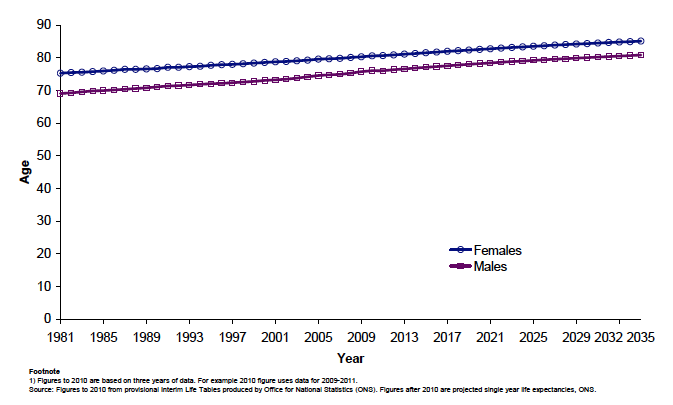
Estimates of life expectancy presented in this chapter use population estimates based on the 2001 Census and are the same as those published in the previous edition of this publication. New life expectancy estimates using population estimates based on the 2011 Census will be published in Spring 2014.
Although mortality rates in Scotland have generally fallen more slowly than in the rest of the UK and elsewhere in Europe, the improvements are still considerable and the impact is reflected in the steadily rising expectation of life.
The expectation of life at birth is a commonly used measure of mortality which is particularly helpful in comparing the 'health' of a nation through time and for making comparisons with other countries as well as for areas within Scotland. Figure 4.1 shows that the expectation of life at birth in Scotland has improved greatly over the last 25 years or so, increasing from 69.1 years for men and 75.3 years for women born around 1981 to 76.1 years and 80.6 years respectively for those born around 2010. Figure 4.1 also illustrates that improvements in life expectancy at birth are projected to continue, rising to 80.9 years for men and 85.1 years for women by 2035.
Figure 4.1: Expectation of life at birth, Scotland, 1981-20351

In addition, Figure 4.1 shows that the gap between male and female life expectancy at birth has decreased from 6.2 years in 1980-1982 to 4.5 years in 2009-2011 and has been closing since 2000-2002.
The improvement in life expectancy at birth for males and females in Scotland since 1997-1999 can also be seen in Figure 4.2a (males) and Figure 4.2b (females). Comparisons are given with life expectancy in the United Kingdom (UK), countries within the UK and the countries that typically have the highest and lowest life expectancy in the European Union (EU) (Sweden and Lithuania for males and France and Romania for females).
Figures 4.2a and 4.2b show that Scottish men and women have relatively low expectation of life at birth compared with the rest of the UK. The UK average is 78.1 years for males and 82.1 years for females and the gap between UK and Scottish life expectancy is now wider than in 1997-1999, by 0.2 years for males and by 0.3 years for females.
Figure 4.2a: Life expectancy at birth in selected countries, 1997-1999 to 2008-2010 Males
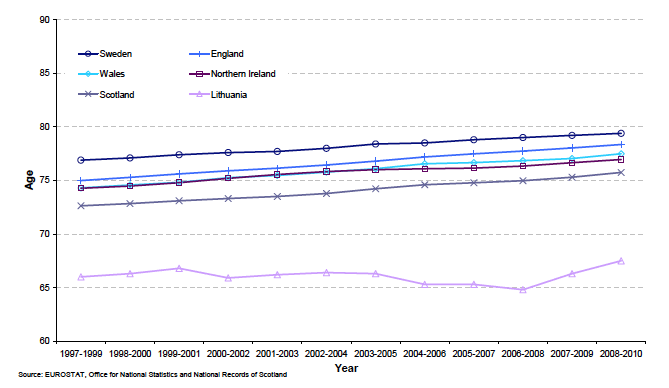
Figure 4.2b: Life expectancy at birth in selected countries, 1997-1999 to 2008-2010 Females
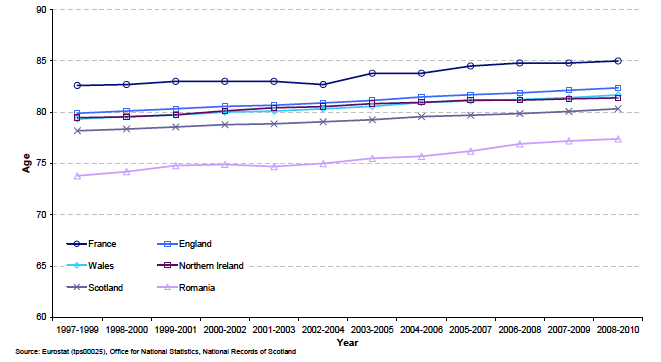
Nevertheless Scottish male life expectancy has improved since 1997-1999, reducing the gap (currently 3.6 years) with Sweden, the country with the highest life expectancy, and increasing the gap with Lithuania, the country with the lowest life expectancy in the EU.
For females however, the gap (currently 4.7 years) between Scotland and France, the country with the highest female life expectancy in the EU, has become wider since 1997-1999. For the same period, the gap between Scotland and Romania, the country with the lowest female life expectancy, has narrowed.
Within Scotland, there are considerable differences in life expectancy at birth between different council areas as illustrated in Figure 4.3. For men, the council area with the lowest life expectancy was Glasgow City (71.6 years), and the council area with the highest life expectancy was East Dunbartonshire (79.4 years), 7.8 years more than Glasgow City. For women, East Dunbartonshire also had the highest life expectancy (82.7 years), 4.7 years more than Glasgow City, the area with the lowest figure (78.0 years).
Figure 4.3: Life expectancy at birth, 95% confidence intervals1 for Council areas, 2008-2010 (Males and Females)
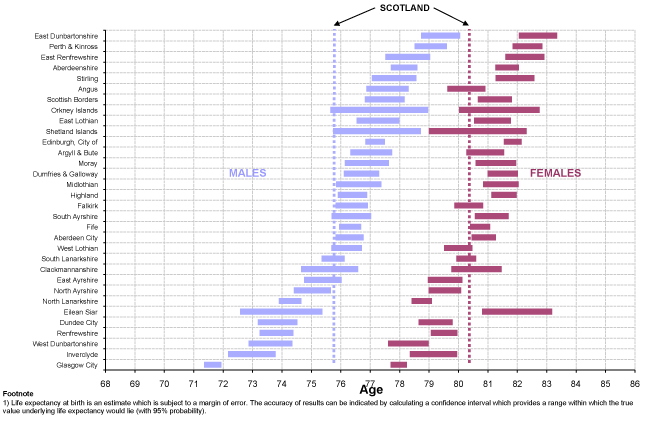
Please Note: that the Scotland-level life expectancy estimates shown in this chart are for use only as a comparator for the corresponding sub-Scotland-level figures. The definitive Scotland-level life expectancy estimate (based on interim life tables) is published by the Office for National Statistics.
There are also differences between urban and rural areas as shown in Figure 4.4. Men in rural areas - remote and accessible - can expect to live just over 3.5 years longer (78.0 and 78.3 years respectively) than men in large urban areas (74.5 years). Women in rural areas - remote and accessible - can expect to live around two years longer (82.2 and 81.8 years respectively) than women in large urban areas (79.8 years).
Figure 4.4: Life expectancy at birth, 95% confidence intervals1 for Urban and Rural2 areas, 2008-2010 (Males and Females)
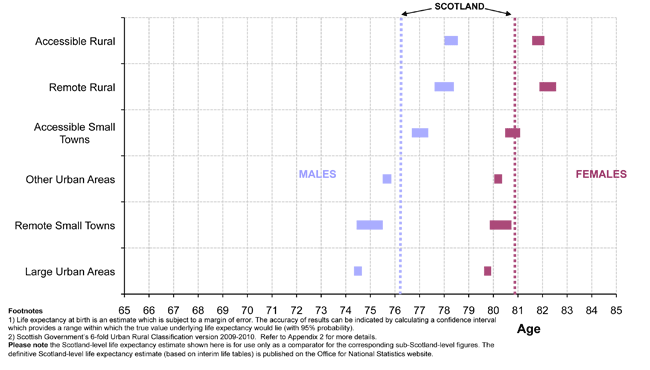
Please Note: that the Scotland-level life expectancy estimates shown in this chart are for use only as a comparator for the corresponding sub-Scotland-level figures. The definitive Scotland-level life expectancy estimate (based on interim life tables) is published by the Office for National Statistics.
A more detailed picture of the large geographical variations in life expectancy can be seen in the 36 Scottish Community Health Partnership (CHP) areas[4]. The principal aim of the CHPs, which link NHS and council services, is to improve the long-term health and wellbeing of communities and enhance the quality of health and social care services. Life expectancy at birth in the 36 CHP areas is shown in Figure 4.5. Men in East Dunbartonshire CHP area can expect to live around eight years longer than men in Glasgow City area (79.4 years compared with 71.7 years respectively). Women in East Dunbartonshire CHP area can expect to live around five years longer than women in Glasgow City CHP area (82.7 years compared with 78.0 years respectively).
Figure 4.5: Life expectancy at birth, 95% confidence intervals1 for Community Health Partnership (CHP) areas, 2008-2010 (Males and Females)
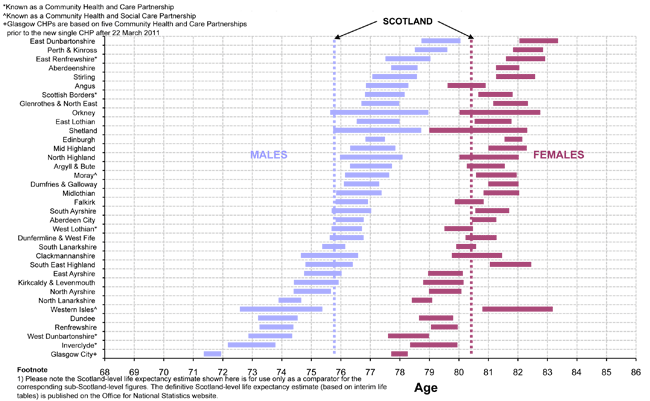
The percentage change in life expectancy at birth in CHP areas over the ten year period 1998-2000 to 2008-2010 is illustrated in Figures 4.6a and 4.6b (ordered from left to right by lowest to highest life expectancy in 1998-2000). The improvement at the national level over the ten year period was 4.1% for men (or 3.0 years) and 2.6% for females (or 2.1 years) and is shown by the heavy horizontal lines across the charts.
In the ten years since 1998-2000, life expectancy at birth has increased in almost all CHP areas, although in some cases the increase or decrease was by a margin so small that it may be a consequence of the volatile nature of life expectancy estimates in small areas. For men, the largest increase in life expectancy at birth was in Mid Highland with 7.0% (an improvement of 5.0 years) and for women in Edinburgh with 3.6% (an improvement of 2.9 years). The gap between the area with the highest male life expectancy at birth and the area with the lowest has increased by 0.1 years over the ten year period from 7.6 years to 7.7 years; for females it has decreased from 5.7 years in 1998-2000 to 4.7 years in 2008-2010. The gap between male and female life expectancy narrowed in all but four of the CHP areas. The gap decreased most in Orkney (4.1 years in 2008-2010 compared with 7.4 years in 1998-2000).
Figure 4.6a: Percentage change in life expectancy, 1998-2000 to 2008-2010, in Scotland and for each individual Community Health Partnership (CHP) area, Males
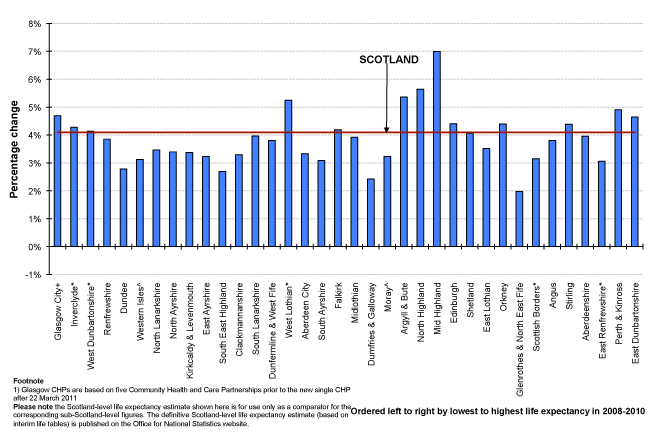
Figure 4.6b: Percentage change in life expectancy, 1998-2000 to 2008-2010, in Scotland and for each individual Community Health Partnership (CHP) area1, Females
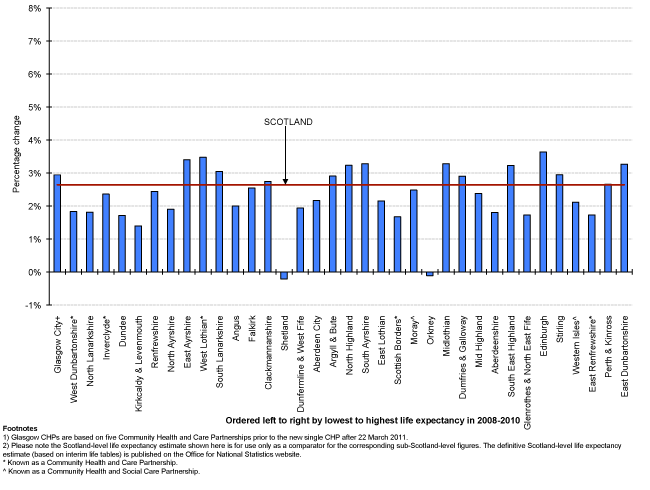
In Glasgow City CHP area (which had the lowest life expectancy at birth in 1998-2000), male life expectancy has improved by 4.7% (or 3.2 years) over the last ten years which is 0.6 percentage points more than the average improvement experienced by Scotland. By contrast, life expectancy at birth for men in East Renfrewshire CHP (the area ranked highest in 1998-2000) improved but at the rate of 3.1%, one percentage point below the average rate of improvement in Scotland.
Female life expectancy in Glasgow City CHP, where it was lowest in 1998-2000, has improved by 2.9% in the ten years since then. Although it is still the lowest in Scotland, its rate of improvement is 0.3 percentage points above the average improvement for Scotland.
Life expectancy decreases as deprivation increases, as illustrated by Figure 4.7. Men in the 10% least deprived areas of Scotland can expect to live around 13.1 years longer than those in the 10% most deprived areas (81.4 years compared with 68.2 years). Women in the 10% least deprived areas of Scotland can expect to live around 9.0 years longer than those in the 10% most deprived areas (84.6 years compared with 75.7 years).
Figure 4.7: Life expectancy at birth, 95% confidence intervals1 by level of deprivation2, 2008-2010 (Males and Females)
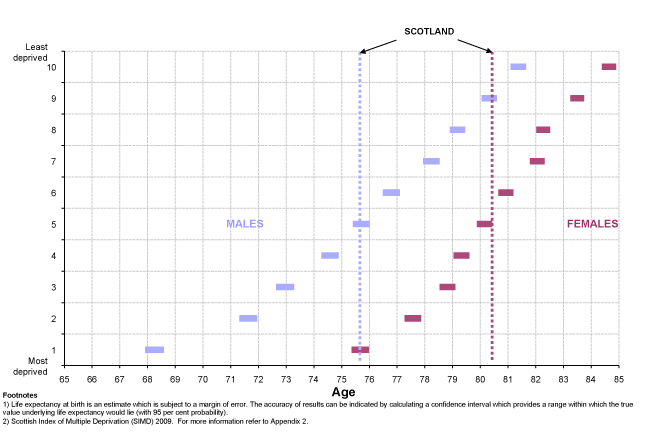
Please Note: that the Scotland-level life expectancy estimates shown in this chart are for use only as a comparator for the corresponding sub-Scotland-level figures. The definitive Scotland-level life expectancy estimate (based on interim life tables) is published by the Office for National Statistics.
A useful extension of life expectancy estimates is information on Healthy Life Expectancy (HLE) which is published by the Information and Statistics Division of the NHS. HLE is defined as the number of years people can expect to live in good health. The difference between HLE and life expectancy indicates the length of time people can expect to spend in poor health. More information on HLE in Scotland is available on the website of the Scottish Public Health Observatory (ScotPHO).
More information about life expectancy statistics
More detailed information about Scotland's life expectancy can be found on the NRS website.